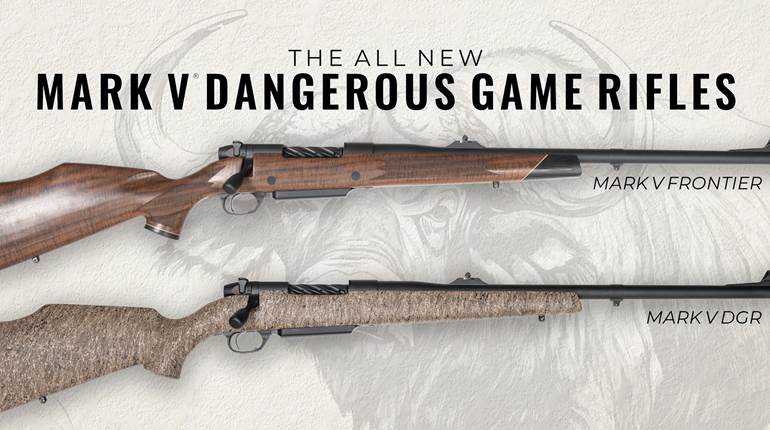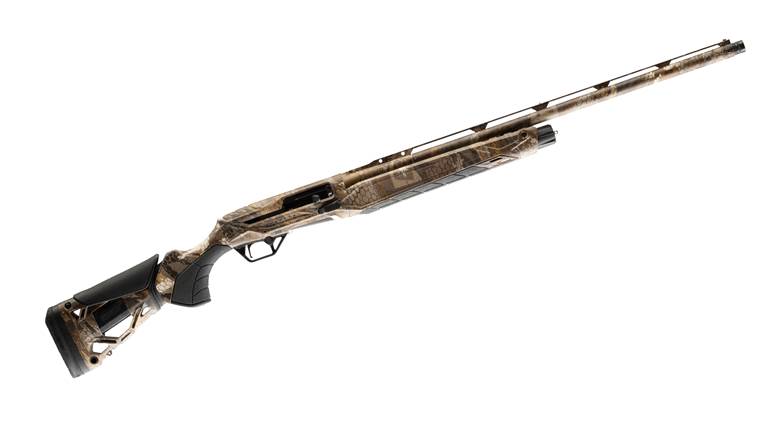
This article appeared originally in the September 2006 issue of American Rifleman. To subscribe to the magazine, visit the NRA membership page and select American Rifleman as your member magazine.
The Rio Grande gobbler had come as close as he was going to come. He stood his ground on the far side of the dirt two-track that ran through Texas’ Nail Ranch, wanting no part of becoming the punch line to a species variation of “Why did the chicken cross the road?” (The answer would be: “To walk into shotgun range.”) Instead, he strutted in a mesquite flat, while I sat in a dilapidated barnyard with my back against a fencepost, trying hard to look like woven wire.
The gobbler displayed for 10 minutes, then folded up his fan and started to leave. Shoot or let him walk? Up until that very day, I had bragged about shooting all my turkeys inside 35 yards. Time to eat my words instead of my tag; I put the crosshairs on his neck, pulled the trigger, and the bird fell flat. My guide measured the distance from my fencepost to the turkey with his laser rangefinder: 50 yards exactly.
Credit that long-range gobbler to interchangeable choke tubes. The XX-Full tube screwed into the muzzle of the Benelli M1 gave me the confidence to try the shot. Shooting at the pattern board with a variety of chokes and loads had proved to me that this particular combination would deliver lethal clusters of pellets at long range.

The interchangeable choke stands as one of the most significant advances of our lifetimes in shotgunning. They give shooters the ability to tailor chokes and loads to specific purposes, as I did with that turkey gun. And they let one gun do the work of several. Had I the time and inclination on that Texas hunt, I could have switched to an Improved Cylinder choke and No. 6 shot and gone on a jack rabbit safari, I could have screwed-in a rifled tube and loaded sabot slugs for feral hogs or exotic deer, or I could have switched to Improved Modified and shot No. 4 buck for coyotes and bobcats.
Arguably, too, interchangeable tubes have changed shotgunning by enabling gunsmiths to easily experiment with choke boring. In the days of fixed chokes, it was easy for a gunsmith to open a choke but very difficult to tighten one. And experimenting with different borings required a whole barrel. No longer; nowadays a gunsmith can make a tube, screw it into a barrel, pattern it, and if it doesn’t work, he can unscrew it and throw it away.
Surprisingly, variable chokes have been around for as long as choke boring itself. Although some accounts say choke boring began around 1827, 1866 is widely accepted as the year choke was invented. Depending on whom you believe, the choke was the brainchild of either Illinois market hunter Fred Kimble, Massachusetts inventor Sylvester Roper or Englishman W.R. Pape. Both Roper and Pape patented chokes within a few weeks of one another in 1866.

What’s not open to debate is that Roper’s device was the first interchangeable choke. Roper was a classic 19th century Yankee tinkerer whose steam-powered motorcycle can be seen at the Smithsonian. Roper built a cartridge-firing repeating shotgun in 1866. Among its innovations were interchangeable chokes in the form of rings of various constrictions that threaded onto the end of the barrel. Unfortunately, Roper’s gun was a failure, and the idea of interchangeable chokes faded along with it—at least for a time.
In 1929, Lyman Gunsight Company acquired the rights to the Cutts Compensator. Originally designed as a brake to reduce muzzle rise on BARs and Thompson submachine guns, the Cutts became a common sight on skeet guns in the 1930s. Lyman’s version of the Cutts for shotguns consisted of a muzzle brake permanently attached to the barrel with a threaded end onto which you could screw choke tubes. Skeet shooters liked the extra muzzle weight and reduced recoil the Cutts provided. Some hunters used them too, but the device never gained broad popularity.
The Poly-Choke was invented around the same time as the Cutts. Not interchangeable in the sense of being a screw-in tube, the Poly-Choke—which is still made today—consists of a collet that threaded onto a muzzle that had a series of longitudinal slits cut in the end. Tightening the collet pushes the petals of the muzzle together, increasing the choke constriction. Poly-Chokes require permanent, aftermarket installation, however companies like Mossberg offered guns with factory Poly-Choke-like devices.
Interchangeable chokes sprouted from muzzles again in the 1950s. Mossberg’s inexpensive 185 and 183 bolt-action shotguns featured chokes that screwed onto the muzzle. At the other end of the price spectrum, Perazzi’s Ennio Matarelli patented a screw-in choke for his company’s over-under target guns around the same time.

Winchester’s innovative Model 59 featured a barrel made from a steel core wrapped with 500 miles of fiberglass thread. It was light, strong, and after 1961, it could be had with screw-in Versalite choke tubes. Although the 59 found favor with a few grouse hunters, it didn’t last. Like Roper’s chokes, Versalites died with their platform gun but were soon reborn as Winchokes. Surprisingly, the first Winchokes were available on Model 1200 pump guns all the way back in 1964.
In the early 1970s, Seattle gunsmith Stan Baker began overboring shotgun barrels, threading them for Winchoke tubes and installing them in high-end target guns. At first, Baker could only put tubes in single barrels and over-under guns, like Kreighoffs and Remington 3200s, that had separated barrels.
Around 1977, Texan Jess Briley, who learned how to machine steel to exacting tolerances while building oilfield equipment, developed thin-wall choke tubes that could be fitted to guns without bulging the barrels. Briley’s first customers were Mexican live-pigeon shooters, but the chokes quickly caught on among target shooters and hunters north of the border as well. Since then, “Brileyed” has practically become accepted as a verb. The tubes can be retrofitted into almost any barrel; I’ve had both an older Beretta and a Fox Sterlingworth Brileyed, and you can’t tell either gun has been altered without looking down the muzzle—which I would not recommend.
Around the same time Briley was putting tubes in high-end pigeon guns, gun manufacturers decided choke tubes weren’t just a gimmick. In the 10-year span between 1977 and 1987, gunmaking giants Browning, Mossberg, Remington, Ruger and Beretta all introduced proprietary choke-tube systems. Now, it’s difficult to buy a gun without interchangeable chokes, and there’s a thriving aftermarket choke-tube industry as well.
- 1866 ⇒ Depending on whom you believe, the choke was the brainchild of either Illinois market hunter Fred Kimble, Massachusetts inventor Sylvester Roper or Englishman W.R. Pape. Both Roper and Pape patented chokes within a few weeks of one another in 1866.
- 1929 ⇒ Lyman Gunsight Company acquired the rights to the Cutts Compensator. Originally designed as a brake to reduce muzzle rise on BARs and Thompson submachine guns.
- 1950 ⇒ Interchangeable chokes sprouted from muzzles again in the 1950s
- 1970 ⇒ In the early 1970s, Seattle gunsmith Stan Baker began overboring shotgun barrels, threading them for Winchoke tubes.
- 1977 ⇒ Around 1977, Texan Jess Briley developed thin-wall choke tubes that could be fitted to guns without bulging the barrels.
Extended Tubes
Even beautifully engraved high-grade sporting clays guns have extended tubes sticking out of the muzzles. Shotgunners have obviously come to accept the aesthetics of protruding chokes, or at least they decided the advantages of an extended tube outweigh the non-traditional look.
Extended tubes offer a couple of advantages: You can screw them in and out without a wrench. If you shoot a lot of hard steel or tungsten shot, you risk damaging only the end of the choke, not the muzzle of your gun.
As a rule of thumb, the longer the choke, the better it will perform. Most longer chokes contain both a conical section where the shot charge is constricted and a parallel section that seems to allow the pellets to settle down after being swaged through the constriction. The parallel-conical design results in patterns with fewer flyers and better center density.
I’ve seen dramatic improvements in patterns when I’ve compared Browning Invector, Winchoke and Mossberg Accu-Choke tubes, which are all quite short, to longer aftermarket tubes in the same gun. That said, in my experience, longer flush-mounted choke systems like Browning’s Invector Plus or Benelli’s Crio Chokes give excellent patterns without ruining the traditional looks of a gun.

Extended tubes do away with the need for choke-tube wrenches. You only have to screw tubes in finger-tight. Be sure the tube is completely seated in the muzzle. There’s no need to crank it in so hard it’s difficult to remove.
Specialty Chokes
You can buy aftermarket choke tubes to any constriction your heart desires, from wide-open—even gently rifled to disperse pellets—down to super-tight for turkeys. Turkey chokes have constrictions of up to 0.090", three times the constriction of a standard full. Such a super-full choke produces incredibly tight patterns that are too dense in the center and weak in the fringes for wingshooting, but they cluster pellets into a 10" circle for the specific purpose of saturating the head and neck of a turkey with shot.
Extended rifled tubes shoot shotgun slugs very well. I once shot five sabot slugs into 1 7⁄8" from 100 yards with a rifled tube in a Browning BPS.
Chokes like the Patternmaster and Wad Wizard take a different approach; instead of constriction to produce tight patterns, they make use of studs that grab the wad as it passes through the choke for better wad/shot column separation. Such chokes are especially effective in patterning large steel pellets for long-range waterfowl shooting. You can even buy an interchangeable/changeable choke that screws into the muzzle such as a Poly-Choke or a Titan Choke from Truglo.

Although choke makers claim that ports and slits reduce recoil, I’m not convinced they do. The one exception that may win the award for “Ugliest Choke Tube Ever” is Briley’s comp tube. With the looks of a pistol compensator, the Comp Tube works exactly the same way, directing gases upward to dampen muzzle jump and recoil. I put one on the light, hard-kicking autoloader that I used to shoot skeet and noticed a dramatic difference in recoil.
Choke Maintenance
You should lubricate the threads in your chokes to keep them from seizing. Otherwise, they can stick in the gun, which ruins the concept of interchangeability. I like Birchwood Casey’s choke-tube lube, which is great stuff, if messy. You can use a couple of drops of oil if you like, but grease works best since it doesn’t migrate.
Always loosen and re-seat tubes after a day in the field. And while you don’t have to crank chokes in super-tight, you should check them occasionally during a day of shooting to make sure they haven’t turned loose.
You have to be especially careful with rifled choke tubes. The rifling runs the same way as the threads—otherwise, the slugs would spin the tube out of the muzzle. What happens is the spinning slug torques the tube tighter with every shot. You have to loosen the tube every three or four shots. If not, by the end of the shooting session, your choke will have screwed in so tightly it won’t come out. I have learned this the hard way. You then have to take the barrel to a gunsmith who can get the choke out, but it’s usually destroyed in the process.

Whenever I clean a gun thoroughly, I remove the choke tube and clean off the old grease with a plastic brush. The easiest way to clean plastic fouling off a tube is to drop it into a jar of solvent like Gun Scrubber and leave it for a few hours.
Treat tubes carefully. Drop one, and you can ding the edge, creating a snag that could catch a wad in the muzzle. A gunsmith can usually smooth the dents, leaving the tube as good as new.
Despite the “pocket full of barrels” nickname that choke tubes earned early, I don’t see many people carrying tubes in the field and changing them according to conditions. But like many others, I change tubes at home all the time. What choke tubes do is allow one gun to do the work of several. You no longer have to own an early season, open-choked pheasant gun and a late-season tight-choked gun; you just switch tubes. Granted, that undermines a good excuse to buy more guns, but overall, choke tubes represent significant progress. It took choke tubes 140 years to arrive, but they’re definitely here to stay.





































